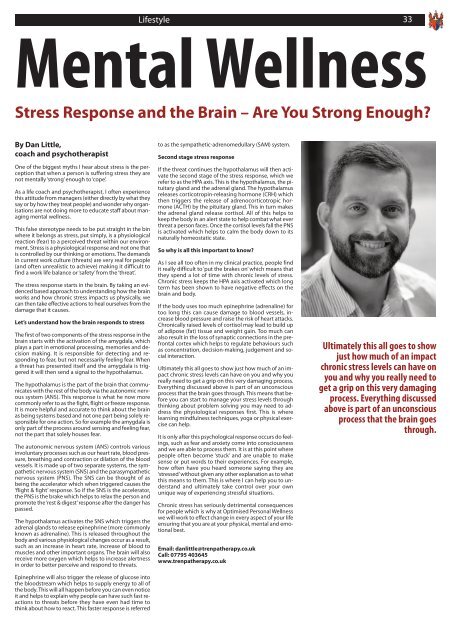Messenger December 2017
You also want an ePaper? Increase the reach of your titles
YUMPU automatically turns print PDFs into web optimized ePapers that Google loves.
Lifestyle 33<br />
Mental Wellness<br />
Stress Response and the Brain – Are You Strong Enough?<br />
By Dan Little,<br />
coach and psychotherapist<br />
One of the biggest myths I hear about stress is the perception<br />
that when a person is suffering stress they are<br />
not mentally ‘strong’ enough to ‘cope’.<br />
As a life coach and psychotherapist, I often experience<br />
this attitude from managers (either directly by what they<br />
say or by how they treat people) and wonder why organisations<br />
are not doing more to educate staff about managing<br />
mental wellness.<br />
This false stereotype needs to be put straight in the bin<br />
where it belongs as stress, put simply, is a physiological<br />
reaction (fear) to a perceived threat within our environment.<br />
Stress is a physiological response and not one that<br />
is controlled by our thinking or emotions. The demands<br />
in current work culture (threats) are very real for people<br />
(and often unrealistic to achieve) making it difficult to<br />
find a work life balance or ‘safety’ from the ‘threat’.<br />
The stress response starts in the brain. By taking an evidenced<br />
based approach to understanding how the brain<br />
works and how chronic stress impacts us physically, we<br />
can then take effective actions to heal ourselves from the<br />
damage that it causes.<br />
Let’s understand how the brain responds to stress<br />
The first of two components of the stress response in the<br />
brain starts with the activation of the amygdala, which<br />
plays a part in emotional processing, memories and decision<br />
making. It is responsible for detecting and responding<br />
to fear, but not necessarily feeling fear. When<br />
a threat has presented itself and the amygdala is triggered<br />
it will then send a signal to the hypothalamus.<br />
The hypothalamus is the part of the brain that communicates<br />
with the rest of the body via the autonomic nervous<br />
system (ANS). This response is what he now more<br />
commonly refer to as the fight, flight or freeze response.<br />
It is more helpful and accurate to think about the brain<br />
as being systems based and not one part being solely responsible<br />
for one action. So for example the amygdala is<br />
only part of the process around sensing and feeling fear,<br />
not the part that solely houses fear.<br />
The autonomic nervous system (ANS) controls various<br />
involuntary processes such as our heart rate, blood pressure,<br />
breathing and contraction or dilation of the blood<br />
vessels. It is made up of two separate systems, the sympathetic<br />
nervous system (SNS) and the parasympathetic<br />
nervous system (PNS). The SNS can be thought of as<br />
being the accelerator which when triggered causes the<br />
‘flight & fight’ response. So if the SNS is the accelerator,<br />
the PNS is the brake which helps to relax the person and<br />
promote the ‘rest & digest’ response after the danger has<br />
passed.<br />
The hypothalamus activates the SNS which triggers the<br />
adrenal glands to release epinephrine (more commonly<br />
known as adrenaline). This is released throughout the<br />
body and various physiological changes occur as a result,<br />
such as an increase in heart rate, increase of blood to<br />
muscles and other important organs. The brain will also<br />
receive more oxygen which helps to increase alertness<br />
in order to better perceive and respond to threats.<br />
Epinephrine will also trigger the release of glucose into<br />
the bloodstream which helps to supply energy to all of<br />
the body. This will all happen before you can even notice<br />
it and helps to explain why people can have such fast reactions<br />
to threats before they have even had time to<br />
think about how to react. This faster response is referred<br />
to as the sympathetic-adrenomedullary (SAM) system.<br />
Second stage stress response<br />
If the threat continues the hypothalamus will then activate<br />
the second stage of the stress response, which we<br />
refer to as the HPA axis. This is the hypothalamus, the pituitary<br />
gland and the adrenal gland. The hypothalamus<br />
releases corticotropin-releasing hormone (CRH) which<br />
then triggers the release of adrenocorticotropic hormone<br />
(ACTH) by the pituitary gland. This in turn makes<br />
the adrenal gland release cortisol. All of this helps to<br />
keep the body in an alert state to help combat what ever<br />
threat a person faces. Once the cortisol levels fall the PNS<br />
is activated which helps to calm the body down to its<br />
naturally homeostatic state.<br />
So why is all this important to know?<br />
As I see all too often in my clinical practice, people find<br />
it really difficult to ‘put the brakes on’ which means that<br />
they spend a lot of time with chronic levels of stress.<br />
Chronic stress keeps the HPA axis activated which long<br />
term has been shown to have negative effects on the<br />
brain and body.<br />
If the body uses too much epinephrine (adrenaline) for<br />
too long this can cause damage to blood vessels, increase<br />
blood pressure and raise the risk of heart attacks.<br />
Chronically raised levels of cortisol may lead to build up<br />
of adipose (fat) tissue and weight gain. Too much can<br />
also result in the loss of synaptic connections in the prefrontal<br />
cortex which helps to regulate behaviours such<br />
as concentration, decision-making, judgement and social<br />
interaction.<br />
Ultimately this all goes to show just how much of an impact<br />
chronic stress levels can have on you and why you<br />
really need to get a grip on this very damaging process.<br />
Everything discussed above is part of an unconscious<br />
process that the brain goes through. This means that before<br />
you can start to manage your stress levels through<br />
thinking about problem solving you may need to address<br />
the physiological responses first. This is where<br />
learning mindfulness techniques, yoga or physical exercise<br />
can help.<br />
It is only after this psychological response occurs do feelings,<br />
such as fear and anxiety come into consciousness<br />
and we are able to process them. It is at this point where<br />
people often become ‘stuck’ and are unable to make<br />
sense or put words to their experiences. For example,<br />
how often have you heard someone saying they are<br />
‘stressed’ without given any other explanation as to what<br />
this means to them. This is where I can help you to understand<br />
and ultimately take control over your own<br />
unique way of experiencing stressful situations.<br />
Chronic stress has seriously detrimental consequences<br />
for people which is why at Optimised Personal Wellness<br />
we will work to effect change in every aspect of your life<br />
ensuring that you are at your physical, mental and emotional<br />
best.<br />
Email: danlittle@trenpatherapy.co.uk<br />
Call: 07795 403645<br />
www.trenpatherapy.co.uk<br />
Ultimately this all goes to show<br />
just how much of an impact<br />
chronic stress levels can have on<br />
you and why you really need to<br />
get a grip on this very damaging<br />
process. Everything discussed<br />
above is part of an unconscious<br />
process that the brain goes<br />
through.
















